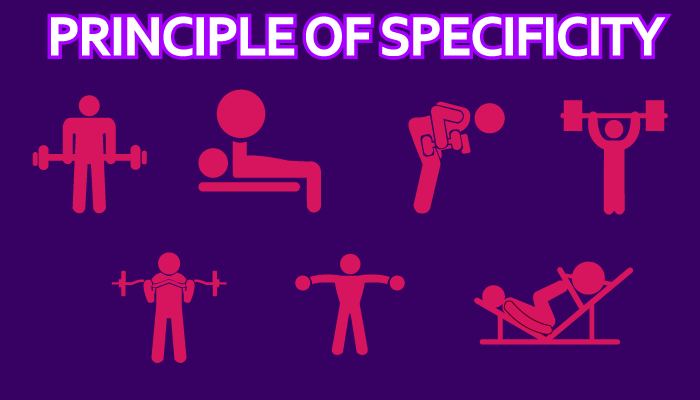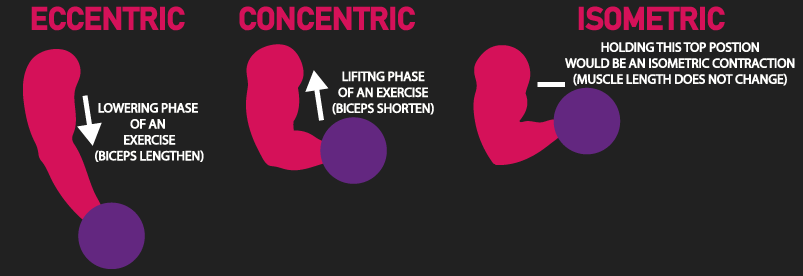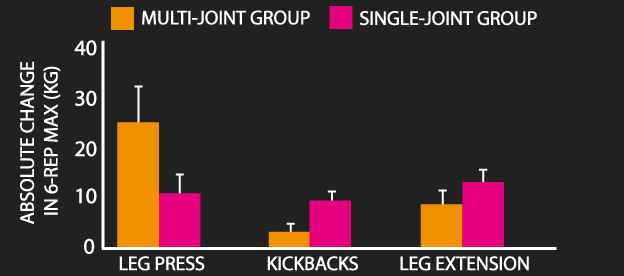
When it comes to understanding the basics of how any type of resistance training program works, the principle of specificity is one of the most fundamental ideas.
Simply put, the principle of specificity states that you see greater improvements in what you train and lesser improvement in what you do not train.
Of course, this makes a lot of intuitive sense. The more you do something, the more you would expect to be better at it.
In this article, we’ll be looking at how the principle of specificity applies to strength and hypertrophy training.
Moreover, although this principle is simple and logical, I also hope to provide insight into some interesting areas that some may not have thought/known about.
This article goes through four different areas of resistance training in which I feel are most relevant in this context: contraction type, rep ranges, range of motion, and the particular exercise.
Table of Contents
Contraction Type
There are three types of muscular contractions: eccentric, concentric, and isometric contractions.
Eccentric contractions are where muscles produce force while lengthening. For instance, during the downwards phase of a biceps curl.
Concentric contractions are where muscles produce force while shortening. For instance, during the upwards (curling) phase of a biceps curl.
Isometric contractions are where muscles produce force while at a constant length. For instance, if you held the dumbbell at the top of the biceps curl.

In a general strength or hypertrophy training program, most exercises involve a concentric and eccentric phase. Using the biceps curl example again, most people typically perform the movement through curling the weight up (concentric) and lowering the weight down (eccentric), without much of a pause between these two phases.
However, there are exercises (or ways to perform an exercise), which means it is entirely a concentric, eccentric, or isometric exercise.
A meta-analysis by Roig et al. demonstrates how the principle of specificity applies to eccentric and concentric only training.
For those unaware, meta-analyses are studies that combine the results of numerous individuals studies that address the same question. Therefore, meta-analyses have greater statistical power and are typically more reliable compared to individual studies.
As you’d expect, the meta-analysis found that eccentric overload training resulted in greater increases in eccentric strength compared to concentric only training.
Interestingly, for concentric strength outcomes, there was no statistically significant difference between eccentric overload training or concentric only training. Though, the results do show tendency towards concentric training.
Therefore, concentric training was *slightly better* for concentric strength than eccentric training.
So, the principle of specificity does appear to hold true with eccentric and concentric training.
As for how isometric training fits into this picture, a 1986 paper by Rutherford and Jones gives us an insight.
They had three different protocols.
Protocol 1 had 6 men perform an isometric leg extension for 4 sets of 6 contractions, three times per week for 12 weeks. Each contraction was held for 4 seconds at 80% of their maximum effort, with 2 seconds of rest between contractions and 1 minute of rest between sets.
As expected, they experienced significant increases in their quadriceps isometric strength (measured by the same exercise used in training). At week 12, this was a 40% increase compared to pre-training.
Protocol 2 had 5 men train the leg extension, but resistance was only applied throughout the concentric phase, making it a concentric only exercise. They performed this for 6 reps at an 80% maximum, three times per week for 12 weeks.
By the 12th week, concentric strength (measured by the same exercise used in training) had increased by a massive 170%, while isometric strength (measured by the exercise used in protocol 1) only increased by 15%.
Protocol 3 had 11 men and 9 women train the regular leg extension (with a concentric and eccentric phase), though there was no back support, for 6 reps, three times per week for 12 weeks.
Strength on the regular leg extension increased by a massive 240% for the women, and 200% for the men. Isometric strength only increased by 20% for the men, and surprisingly 4% for the women.
Summing up this section, the principle of specificity does very much apply to contraction types.
Before moving on, if you’re curious about creating an effective training program for muscle hypertrophy, our high quality partner Alpha Progression can help. It can generate a highly effective program for you, track your workouts live with in-built progression recommendations, provide graphs displaying your long term progress, and it has a massive exercise database with more than 550 exercises.
Click HERE (the link opens in a new tab) to get a free 2 week trial of the apps features. If you like it and go beyond, the link also gives you 20% off a subscription!
We never promote trash at the House of Hypertrophy, so rest assured the app is high quality. The reviews speak to this, 4.8 starts (based on more than 7,000 reviews) on Google play, and 4.9 stars in Apple’s store (based on nearly 400 ratings).
Rep Range/Load
When training to, or close to failure, the number of reps performed and load used share a relationship.
Lower reps require heavier loads, whereas higher reps require lighter loads.
When it comes to maximizing strength on a particular exercise, the principle of specificity would imply that we should use heavier loads and lower rep ranges.
Indeed, a 2017 meta-analysis by Schoenfeld et al. found that using loads equal to or heavier than 60% one-rep max was superior for maximizing strength compared to using loads lighter than 60% one-rep max.
On the opposite side of this, when it comes to maximizing muscular endurance on a particular exercise, the principle of specificity would imply that we should use lighter loads and higher rep ranges.
Campos et al. indeed found that using 20-28 reps per set was superior to using 9-11 reps or 3-5 reps per set for maximizing muscular endurance.
Therefore, to maximize strength or endurance on a particular exercise, the principle of specificity is very much in play.
However, I must emphasize the particular exercise part.
Training with heavier loads on the squat will result in superior strength gains on the squat compared to training with lighter loads. Bu, this does not mean you will be stronger on other exercises or measures of strength.
For example, returning to the 2017 meta-analysis by Schoenfeld et al., we know using heavier loads on an exercise is better for increasing strength (one-rep max) on that exercise versus using lighter loads.
But, when testing isometric strength for the main muscle group involved in that exercise, heavy loads and light loads produced statistically similar outcomes.
This relates back to how the principle of specificity applies to contraction types.
For instance, with a squat, the exercise involves a concentric and eccentric phase. Training heavier loads with this exercise maximizes concentric and eccentric strength on the squat, but it does not perform significantly better than using lighter loads on the squat when it comes to quadriceps isometric force output.
Specifically training that isometric quadriceps force test is likely going to be required to achieve substantial gains here.
Range of Motion
Range of motion refers to the amount of movement that occurs at a joint during an exercise.
Exercises can be performed with a full range of motion or partial range of motion.
For example, a full range of motion in the squat refers to taking the knee and hip joints through the longest range of motion they can go through.
A partial range of motion in the squat refers to only taking the hip and knee joints through a select portion of the range of motion they are capable of going through.

The principle of specificity would imply that if we wanted to get stronger with a full range of motion on an exercise, we should train that exercise with a full range of motion.
Conversely, if we wanted to get stronger with a partial range of motion on an exercise, we should train that exercise with that partial range of motion.
Does the research match up to this?
Let’s take a look.
Pinto et al. found that training full range of motion preacher curls was superior to training partial range of motion preacher curls for increasing one-rep max on the full range of motion preacher curl.
Bloomquist et al. found that training parallel squats (120 degrees of knee flexion) was superior to training partial squats (60 degrees of knee flexion) for increasing parallel squat one-rep max. Also, training partial squats were superior to training parallel squats for partial squat one-rep max.
Similarly, Kubo et al. found that training full squats (140 degrees of knee flexion) was more effective than training half squats (90 degrees of knee flexion) for increasing full squat one-rep max.
Interestingly though, increases in half squat one-rep max was statistically similar between both the full squat and half squat groups. That said, comparing the average percentages, the results do seem to favor the half squat group (32% increase for the half squat group versus 24% increase for the full squat group).
Massey et al. found that training the bench press through a full range of motion was superior to training a partial range of motion bench press, or a combination of both, for increases in full range of motion bench press one-rep max.
So, these 4 studies support the principle of specificity with range of motion.
However, there are studies with contrary findings.
A study by Bazyler et al. found that a training program comprised of full squats and partial squats was equally as effective (if not slightly more effective) than a training program of full squats for increasing full squat one-rep max.
Martínez-Cava et al. had three different groups training the bench press, differing in the range of motion used. One group trained the bench press through its full range of motion, the second trained the bench press using one-third of its range of motion, and the third group trained the bench press with two-thirds of its range of motion.
The full range of motion group experienced superior strength gains on all three range of motions.
Another study by Massey et al. had the same design as their other study. In this one, training the bench press through a full range of motion produced statistically similar increases in full range of motion bench press one-rep max compared to training a partial range of motion bench press or a combination of both.
So, these 3 studies go against the principle of specificity with range of motion.
Therefore, the overall research on range of motion and the principle of specificity is split.
This demonstrates the fact that the principle is a general principle used to describe what we typically expect.
However, it is not a law that must be obeyed. We know this because as demonstrated here, there is evidence against the principle of specificity.
The Kubo et al. and Bloomquist et al. study conflicts with the Bazyler et al. study, while the first mentioned Massey et al. study conflicts with the second Massey et al. study and the Martínez-Cava et al. study.
At the end of the day, more research would be required to explore these conflicts. Moreover, hopefully this research would be able to identify the potential reasons or scenarios explaining where and why the principle of specificity may not apply.
The Particular Exercise
This is probably the most intuitive area to which the principle of specificity applies to with resistance training.
You would expect to experience greater strength gains on the particular exercise you train compared to another exercise.
A study by Stein et al. nicely demonstrates this.
Protocol:
The researchers assigned 52 untrained women into a multi-joint group, single-joint group, or control group.
We won’t mention the control group, as they of course did not train and experienced no strength gains.
The multi-joint group trained the leg press for 3-4 sets of 6-10 reps, two to three times per week for 8 weeks.
The single-joint group trained the machine kickback and leg extension, each for 3-4 sets of 6-10 reps, two to three times per week for 8 weeks.
Measurements:
The researchers assessed a 6-rep max on the leg press, machine kickback, and leg extension before and after the 8 weeks for both groups.
Results:

Following the principle of specificity, the multi-joint group experienced greater strength gains on the leg press compared to the single-jont group.
Also, the single-joint group experienced greater strength gains on the machine kickback and leg extension exercises compared to the multi-joint group.
Interestingly, although the single-joint group did experience greater strength gains on the leg extension compared to the multi-joint group, the multi-joint group still experienced respectable increases. This demonstrates the idea of transferability. The leg press appears to have a decent carryover to the leg extension.
But nonetheless, as dictated by the principle of specificity, if we want to maximize strength gains on a particular exercise, training that exercise is going to be necessary.
Remember to feel free to check out the Alpha Progression App if you’re interested. Also feel free to check out our free bench press e-book below.

